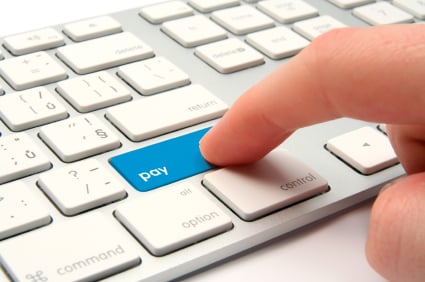5 Must-Have Online Billing and Payment Tools for Healthcare Providers
December 20, 2013 •Brian Watson

 The core element of any high-performing EBPP solution is bill presentment and payment.
The core element of any high-performing EBPP solution is bill presentment and payment.
Although enticing, patients won’t often complete EBPP registration for value-added tools like self-service account management, online messaging, or treatment cost estimation alone.
Yes, they’re part of what makes the online billing process easier and more indispensible. But presentment and payment is the straw the stirs the EBPP drink.
The good news (as far as customer adoption is concerned) is that presentment and payment is precisely where the most EBPP progress has been made over the past few years. Both in terms of technology and execution, the online payment tools of today’s best-class EBPP solutions are miles ahead of where they were just a few short years ago.
Bill notification has expanded past email-only to include channels like mobile and voice announcements. Static PDF presentment has been replaced by dynamic account summaries that automatically update when a new charge or payment is logged and uploaded to the application.
And payment has adapted to the unique demands of the healthcare marketplace. Both in channel (offering payment without enrollment alongside full portals) and in management (enabling the financial tools that healthcare providers rely on, like discounted, planned, and recurring payments).
To ensure your EBPP solution is optimally performing on the all-important payment component, keep these tools at the top of your comparison-shopping checklist.
A Multi-Channel Notification System
Smartphone and tablet use has fundamentally changed online billing and payment. According to research from Google, 69% of U.S. consumers access the “mobile web” every day. To meet that demand, traditional email notification is now sharing space with phone-based messaging. Common options now include:
• Traditional email-based push notification that links patients to your online billing and payment website for bill review and balance payment.
• SMS (text) based notification that also accepts payments via IVR or a mobile website.
• Interactive Voice Response (IVR), an automated, voice-based messaging system that enables front-end push mobile phone notification. Patients receive recorded voice-based phone updates when a bill is made available. And access to back-end automated balance pay tools that allow them to phone in payments (that are tracked and automatically processed) no matter if your business office is open or closed.
Dynamic Accounts
A patient’s account profile can change. Quickly. Credits are applied in the form of insurance payments, point-of-treatment co-pays, and patient payments. And debits arise when additional treatment is provided. In short: it’s a dynamic process.
That’s why it’s critical for EBPP to go beyond simple bill presentment to incorporate a system that better captures the real-time nature of your patients’ accounts. Today’s best-practice solutions present accounts as a snapshot in time; automatically updating website balance due and payments made/pending to reflect new and imminent transaction info.
PDF Statement Presentment
While dynamic accounts are a must-have for EBPP portals, PDF statement presentment is still an important way to inform patients about exactly why they owe. We suggest:
• Using the same billing format online as off-. Uniformity reduces confusion for patients used to a traditional paper bill. Plus makes answering billing questions across all media much easier for your staff.
• Providing patients the option to suggest an itemized bill via your online billing and payment app for drill-down transaction details if they’d like additional info.
A Flexible, Option-Rich Pay System
Options, options, options. That’s the trademark of any successful online payment system. Because healthcare EBPP is unlike any other form of EBPP. Patient billing usually involves multiple payers (insurance and self-pay).
A single transaction can incorporate charges from several providers, practices, and groups. And healthcare businesses serve a patient base that differs greatly in treatment experience, insurance coverage, and financial profile. All that complexity affects online payment. And is a good reason why your approach should emphasize flexible pay tools like:
• A payment without enrollment option that enables patients to pay online using only on-statement info like patient account number and ZIP code.
• A pay system that leverages the financial tools your organization uses to enhance and accelerate self-pay patient revenue. That includes resources like automated balance discounts for prompt payment or EBPP registration, and enabling patients to enroll in payment programs, schedule recurring payments, and check (and revise) pending transactions.
• The ability to collect and process both point-of-service and back office payments.
• The control to establish pre-defined payment options, including minimum and past-due amounts.
• Savable patient pay profiles for fast, accurate repeat payments.
Settlement Control & Reconciliation
Patient payment capture is just the first part of the transaction process. Best-class EBPP solutions also provide funds processing and settlement that’s automated and seamless, including:
• Fast, accurate, and secure bank ACH and debit and credit card payment processing.
• Automated settlement of processed funds.
• Payment activity, posting, and return information that seamlessly integrates with your accounting system for settlement control and reconciliation.
Ready to learn more about the payment tools that power best-practice EBPP solutions? Download our free online patient billing and payment whitepaper The New Rules of Patient EBPP.
Get Updates
Featured Articles
Categories
- Charity Care Management (1)
- Compliance (2)
- Customer Service (8)
- Digital Front Door (1)
- Direct Mail (6)
- eBilling (1)
- EBPP (34)
- ESL Statement (2)
- eStatement (1)
- Healthcare Channel Partner Billing (1)
- IVR (3)
- Mobile Payment (11)
- Online Billing and Payment (6)
- Online Patient Payment (17)
- Outsource Print Management (4)
- Paperless Billing (4)
- Patient Engagement (2)
- Patient Friendly Billing (21)
- Print and Mail (7)
- QR Codes (1)
- Quick Pay (7)
- Security (1)
- Self-Pay Patients (9)
- Self-Pay Revenue (4)
- Statement Design (32)
- Statement Print and Mail (1)
- Statement Printing and Mailing (28)
- Statement Processing (36)
- TransPromo (1)
- Up-Front Billing (1)

